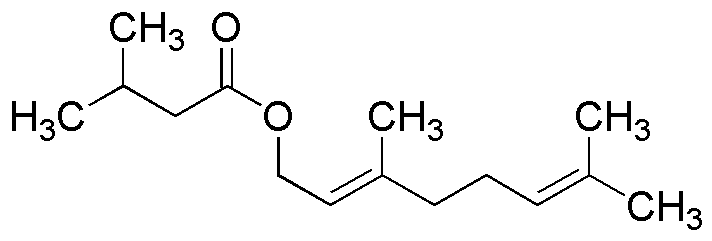Geranyl isovalerate is widely utilized in research focused on:
- Fragrance Industry: This compound is a key ingredient in perfumes and cosmetics, providing a pleasant floral scent that enhances product appeal.
- Flavoring Agent: It is used in food products to impart a fruity flavor, making it popular in the production of beverages and confections.
- Aromatherapy: Geranyl isovalerate is incorporated into essential oils for its calming properties, often used in diffusers and massage oils.
- Pharmaceuticals: The compound is explored for its potential therapeutic benefits, including anti-inflammatory and antimicrobial properties, making it relevant in drug formulation.
- Research Applications: It serves as a model compound in studies related to organic synthesis and natural product chemistry, aiding researchers in developing new compounds.
General Information
Properties
Safety and Regulations
Applications
Geranyl isovalerate is widely utilized in research focused on:
- Fragrance Industry: This compound is a key ingredient in perfumes and cosmetics, providing a pleasant floral scent that enhances product appeal.
- Flavoring Agent: It is used in food products to impart a fruity flavor, making it popular in the production of beverages and confections.
- Aromatherapy: Geranyl isovalerate is incorporated into essential oils for its calming properties, often used in diffusers and massage oils.
- Pharmaceuticals: The compound is explored for its potential therapeutic benefits, including anti-inflammatory and antimicrobial properties, making it relevant in drug formulation.
- Research Applications: It serves as a model compound in studies related to organic synthesis and natural product chemistry, aiding researchers in developing new compounds.
Documents
Safety Data Sheets (SDS)
The SDS provides comprehensive safety information on handling, storage, and disposal of the product.
Product Specification (PS)
The PS provides a comprehensive breakdown of the product’s properties, including chemical composition, physical state, purity, and storage requirements. It also details acceptable quality ranges and the product's intended applications.
Certificates of Analysis (COA)
Search for Certificates of Analysis (COA) by entering the products Lot Number. Lot and Batch Numbers can be found on a product’s label following the words ‘Lot’ or ‘Batch’.
*Catalog Number
*Lot Number
Certificates Of Origin (COO)
This COO confirms the country where the product was manufactured, and also details the materials and components used in it and whether it is derived from natural, synthetic, or other specific sources. This certificate may be required for customs, trade, and regulatory compliance.
*Catalog Number
*Lot Number
Safety Data Sheets (SDS)
The SDS provides comprehensive safety information on handling, storage, and disposal of the product.
DownloadProduct Specification (PS)
The PS provides a comprehensive breakdown of the product’s properties, including chemical composition, physical state, purity, and storage requirements. It also details acceptable quality ranges and the product's intended applications.
DownloadCertificates of Analysis (COA)
Search for Certificates of Analysis (COA) by entering the products Lot Number. Lot and Batch Numbers can be found on a product’s label following the words ‘Lot’ or ‘Batch’.
*Catalog Number
*Lot Number
Certificates Of Origin (COO)
This COO confirms the country where the product was manufactured, and also details the materials and components used in it and whether it is derived from natural, synthetic, or other specific sources. This certificate may be required for customs, trade, and regulatory compliance.

